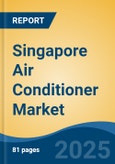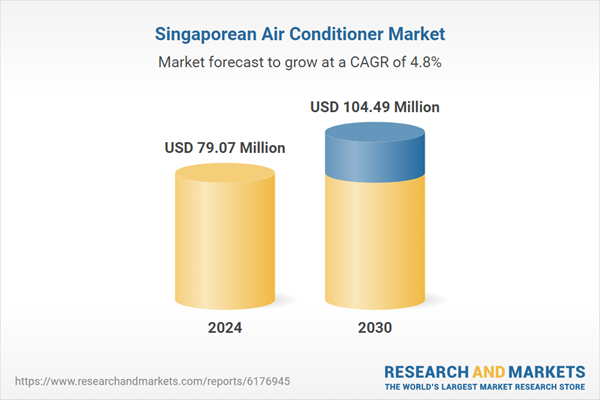Speak directly to the analyst to clarify any post sales queries you may have.
10% Free customizationThis report comes with 10% free customization, enabling you to add data that meets your specific business needs.
The residential sector continues to lead demand, while commercial and industrial applications are also experiencing growth due to infrastructure development and retrofitting projects. Singapore’s urban population reached 5,917,648 in 2023, marking a 4.98% increase from 2022. This growth underscores the nation’s ongoing urbanization, which is a key driver of the air conditioner market. As more people concentrate in urban areas, the demand for residential apartments, office spaces, commercial centers, and public facilities rises sharply, requiring reliable and efficient cooling systems.
Key Market Drivers
Rising Temperatures and Climate Change
Singapore’s tropical climate, characterized by high humidity and consistently warm temperatures throughout the year, has made air conditioning a necessity rather than a luxury. In recent years, the city-state has experienced rising temperatures due to the effects of global climate change and the urban heat island effect. According to meteorological reports, Singapore has seen record-high average temperatures, with more frequent warm nights and hotter days.As a result, the demand for cooling solutions, particularly air conditioners, continues to rise among both residential and commercial users. In 2024, Singapore recorded an annual average temperature of 28.4 degrees Celsius, tying with 2019 and 2016 as the warmest year on record. This milestone reflects the growing impact of climate change and the urban heat island effect, which have led to an increase in both daytime and nighttime temperatures. The frequency of hotter days and warm nights has notably risen, contributing to greater discomfort for residents and heightening the reliance on cooling solutions, this factors drives the market growth.
Consumers are increasingly prioritizing comfort and health, driving purchases of air conditioning units for homes, offices, retail spaces, and public areas. This sustained climatic trend ensures long-term market potential, encouraging manufacturers to innovate and diversify their product offerings to meet growing demand.
Key Market Challenges
High Energy Consumption and Rising Electricity Costs
One of the foremost challenges in the Singapore air conditioner market is the high energy consumption associated with cooling systems, particularly older or less efficient models. Air conditioners are among the most power-intensive home appliances, and their widespread use contributes significantly to household and commercial electricity bills. As Singapore is heavily dependent on imported energy, fluctuations in global energy prices directly impact local electricity costs. This poses a financial burden on consumers, especially lower-income households, and deters some from upgrading or using air conditioners extensively.While inverter and energy-efficient systems are gaining popularity, their higher upfront costs remain a barrier to adoption for cost-conscious buyers. Moreover, with growing concerns about sustainability, excessive electricity use from air conditioning contributes to greenhouse gas emissions, which contradicts Singapore’s national carbon reduction targets. Thus, the challenge lies in balancing comfort, affordability, and environmental responsibility while encouraging the adoption of more efficient technologies.
Key Market Trends
Growing Demand for Smart and Connected Air Conditioning Systems
One of the most prominent trends in the Singapore air conditioner market is the increasing adoption of smart and connected air conditioning systems. With Singapore positioning itself as a “Smart Nation,” there is a strong push towards integrating Internet of Things (IoT) technologies in everyday appliances, including air conditioners. Consumers are becoming more tech-savvy and seeking appliances that provide greater control, convenience, and energy savings.Smart air conditioners allow users to control temperature settings, fan speed, and timers remotely through mobile applications or voice-controlled smart home assistants like Amazon Alexa and Google Assistant. These systems can also track usage patterns and optimize energy consumption, helping reduce electricity bills. Additionally, real-time diagnostics and maintenance alerts are reducing the need for frequent technician visits, improving user experience and system reliability. This trend is expected to gain further momentum as more households and businesses embrace automation and energy management solutions.
Key Market Players
- Philips Singapore Pte Ltd.
- Samsung Electronics Singapore Pte. Ltd. (SESP)
- LG Electronics Singapore Pte.Ltd.(LGESL)
- Xiaomi Technologies Singapore Pte. Ltd.
- Electrolux S.E.A. Pte Ltd
- Daikin Airconditioning (Singapore) Pte Ltd.
- Sharp Singapore Electronics Corporation Pte. Ltd.
- Panasonic Asia Pacific Pte. Ltd
- Sony Electronics (Singapore) Pte. Ltd
- Toshiba Corporation
Report Scope:
In this report, the Singapore Air Conditioner Market has been segmented into the following categories, in addition to the industry trends which have also been detailed below:Singapore Air Conditioner Market, By Product Type:
- Splits
- VRFs
- Chillers
- Windows
- Others
Singapore Air Conditioner Market, By End Use:
- Residential
- Commercial/Industrial
Singapore Air Conditioner Market, By Region:
- North-East
- Central
- East
- West
- North
Competitive Landscape
Company Profiles: Detailed analysis of the major companies present in the Singapore Air Conditioner Market.Available Customizations:
With the given market data, the publisher offers customizations according to a company's specific needs. The following customization options are available for the report.Company Information
- Detailed analysis and profiling of additional market players (up to five).
This product will be delivered within 1-3 business days.
Table of Contents
Companies Mentioned
- Philips Singapore Pte Ltd.
- Samsung Electronics Singapore Pte. Ltd. (SESP)
- LG Electronics Singapore Pte.Ltd.(LGESL)
- Xiaomi Technologies Singapore Pte. Ltd.
- Electrolux S.E.A. Pte Ltd
- Daikin Airconditioning (Singapore) Pte Ltd.
- Sharp Singapore Electronics Corporation Pte. Ltd.
- Panasonic Asia Pacific Pte. Ltd
- Sony Electronics (Singapore) Pte. Ltd
- Toshiba Corporation
Table Information
| Report Attribute | Details |
|---|---|
| No. of Pages | 81 |
| Published | September 2025 |
| Forecast Period | 2024 - 2030 |
| Estimated Market Value ( USD | $ 79.07 Million |
| Forecasted Market Value ( USD | $ 104.49 Million |
| Compound Annual Growth Rate | 4.8% |
| Regions Covered | Singapore |
| No. of Companies Mentioned | 10 |









